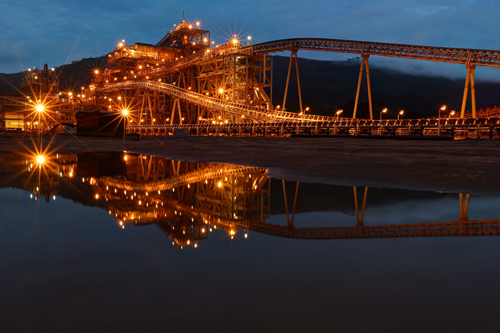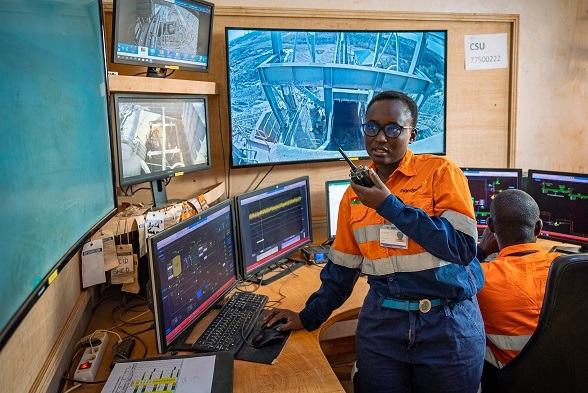
African Minerals (AML) started life in 1996 as the Sierra Leone Diamond Company, focused on Sierra Leone’s deposits of alluvial diamonds. In 2005 it raised £20 million on London’s AIM market and three years later confirmed its Tonkolili magnetite resource in Sierra Leone’s Northern Province.
Financing the Tonkolili project and fast tracking it to production was a priority and the company set about raising funds. Through 2010 and early 2011 it raised over $1.1 billion to fully fund Phase I development of the project, which went into production in late 2011. In March 2012 the Company completed a landmark $1.5 billion transaction with Shandong Iron and Steel Group (SISG) in return for a 25 percent shareholding in the Tonkolili project companies. The SISG transaction is the largest ever foreign investment in Sierra Leone and the largest single investment by a Chinese state-owned enterprise in Africa: as part of the deal SISG secured a proportion of the ore from the mine under an offtake agreement.
The company chose not to follow the usual timeline of carrying out the initial scoping study, definitive engineering study and bankable feasibility study before seeking funding, commencing construction, and starting up operations. Many of the normal processes were tackled simultaneously rather than sequentially. The company was still defining and extending the deposit as construction went ahead, though the risk was small, with the quality and quantity of the 12 billion ton deposit already well understood.
Since Tonkolili is located 200 kilometres inland secure rail and port facilities were as important as the mine itself. Back in November 2008 AML had secured a 99 year lease on the rail and port infrastructure surrounding the project. Fortunately, there was some pre-existing infrastructure from a previous mine operation which enabled the company to fast-track the development of the port operation at Pepel, as well as the first 74 kilometres of the railway—essentially a rehabilitation of what had previously existed. Currently ore from Tonkolili is shipped out of Pepel port, which has limited draft but is the principal iron ore port for Sierra Leone currently.
Originally the plan was to upgrade the nearby port of Tagrin as a deepwater facility that could cope with the vastly increased volumes expected in Phase II and beyond but in December 2012 the company announced its intention to abandon the Tagrin development, which would involve construction of a new rail spur as well, and continue to use Pepel, upgrading the infrastructure there instead.
As CEO Keith Calder commented: “We have made good progress with value engineering and optimisation in our Tonkolili mine expansion strategy. While our strategy regarding the mine and plant is mostly unchanged, we have now decided to leverage our existing rail and port infrastructure at Pepel to achieve the expanded export tonnage. This will significantly reduce capital costs, and de-risk the project's delivery, whilst at the same time reducing social and environmental impacts. This approach will provide a significantly better value, capital efficiency and risk proposition for all of our stakeholders.”
Phase II will see the product change from 20 million Tons per annum (tpa) of straight ore (known as direct shipping ore) to concentrate from Tonkolili’s saprolite haematite reserves at an estimated rate of 35 million tpa, and now that shipping will remain at Pepel the estimated cost of the total expansion plan has come down by a third to $2 billion, with reduced risk and lower environmental and social impact, says AML.
So many discoveries have been made in the region that people in the industry are beginning to call West Africa the new Pilbara, after the massive iron ore fields in Western Australia. Certainly it promises to provide a viable alternative for the Chinese steel manufacturers, whose demand for iron ore cannot be satisfied by present day world resources. Tonkolili, with enough resources to last to the end of this century, will play a significant part in making this happen, and is clearly vital to Sierra Leone’s reconstruction and onward economic development. This project alone is expected to double the county’s GDP once Phase II is under way in 2016.
A major employer, taking direct and sub-contract labour into consideration, AML is committed to replacing expatriates with local personnel. This means promoting local people to supervisor roles as soon as their skills are sufficiently developed. It creates a culture of job progression, lower turnover of staff and the understanding that mining is a career choice that makes sense in a country where jobs in the sector are certain to increase.
For those in the community who don’t plan to make a career in mining, however, AML’s innovative business incubator programme helps them benefit from the presence of the mine. Not content with arm’s length, AML is physically going into the local communities and carrying out skills assessments to identify what skills already exist there and how entrepreneurship could be encouraged. 12 small businesses are now in the scheme, around 80 percent of them food suppliers providing fruit, vegetables and rice to the various sites within the project. In addition, the company has supported tailoring and brickmaking businesses.
Written by John O'Hanlon, research by Robert Hodgson



 AfricanMinerals-Africa.Mining-Mar13-Bro-s.pdf
AfricanMinerals-Africa.Mining-Mar13-Bro-s.pdf








